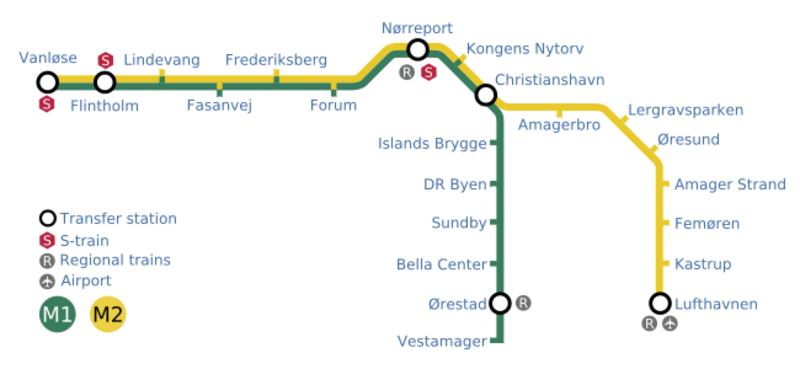The Copenhagen Metro is a modern driverless light rail system that has two lines, both of which offer service to 22 stations. Nine of those stations are built underground.
The lines are 20.4 kilometers in length, and are connected to three cities: Frederiksberg, Copenhagen and Tårnby. These cities belong to a metropolitan area.
The system has a connection available towards Copenhagen’s Airport, and it is available 24 hours a day, 7 days a week. The train frequency varies depending of the time of day. During peak hours, the train frequency ranges between two and three minutes.
The Copenhagen Metro is divided by zones, and the price of the tickets varies depending on the number of zones that the user wants to visit. A ticket for two zones costs 24 Danish kroner (DKK). A single ticket could be used for both the trains and the buses. In other words, you have many available options for transportation with a single payment.
A new line, called the Cityringen line, is planned to be operational by 2019, which will add 17 stations to the current metro system. Later, on 2020, two new stations will be operational, which will serve as an expansion for the Nordhavn station. Also, the Sydhavn line is planned to begin operations on 2024.
Metros in Denmark: Copenhagen Metro
A bit of history
Denmark’s Parliament approved the construction of a light rail service for Copenhagen through the Ørestad Law of 1992.
Afterwards, on 1993, many firms and corporations were created for the construction and inauguration of the system. The participants on this process were the district of Copenhagen and Frederiksberg, and the Ministry of Transport of Copenhagen, Denmark.
The system was part of the integral program of remodeling of the Ørestad area. This was done with the help of the Ørestad Development Corporation, which was in charge of these renovation works in the city.
Phase one of the construction of the system began on 1996, which was done by the Copenhagen Metro Construction Group firm. This firm was responsible of the construction of the lines. Meanwhile, the Ansaldo STS firm was the group in charge of the construction of the technology within the trains, as well as building the trains themselves.
The Denmark Ministry of Transport, the cities of Frederiksberg and Copenhagen comprise the Metroselskabet group. As such, they are owners of the system. Through a contract, the Metroselskabet group assigned the management of the metro to the Metro Service firm.
The construction of the system was done in three phases. It was done in the following way:
- Phase 1: It consists of the route that begins at Nørreport and ends at Vestamager and Lergravsparken. It was inaugurated on October 19th, 2002 by Queen Margrethe II.
- Phase 2: On May, 2003, the route between Nørreport and Frederiksberg was opened. On October of that same year, a new metro station was opened at Vanløse. Later, on 2003, the third phase of the construction began.
- Phase 3: The section between Lufthavnen and Lergravsp, which includes a station at the airport, and the East Amager line were inaugurated on 2007. The inauguration was carried by Prince Frederik during a ceremony done at Lufthavnen station.
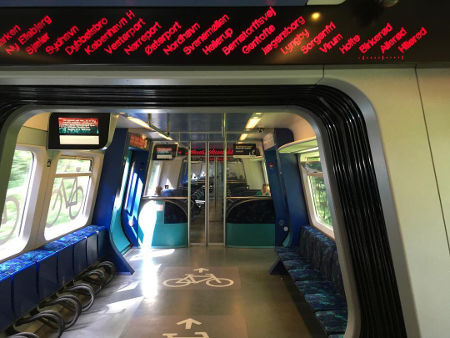 Copenhagen Metro
Copenhagen Metro
Lines and stations
The Copenhagen Metro stations have a Scandinavian classic design which is both aesthetic and practical. Nine of the stations are located underground, and 13 are located at surface-level.
To access the underground stations, you´ll need to go through a tower of elevators, which are decorated with glass pyramids. These pyramids´ function is to illuminate the stations with natural light in order to save energy.
The stations located at above ground level, including both surface-level stations and elevated stations, have structures made of glass and steel and have a light design. The stations located underground also have a similar structure and design.
The metro is comprised of 34 trains of three wagons each. These trains have “flexible zones”, or in other words, seats that can be folded by the sides to give space to people so that they can put their strollers, wheelchairs, and bicycles.
The metro’s headquarters are located at the Vestamage station. At this place, the routes for all lines are scheduled and monitored.
From Vanløse station to Christianshavn, the lines go through the same tunnel or branch. When the trains reach the latter station, the trains from line 1 go from Örestad to Vestamager, while the trains from line 2 go from Østamager to reach the Copenhagen Airport.
It will take you only 15 minutes to go from Nørreport station to the airport. Meanwhile, it takes 14 minutes to go from Nørreport to Vestamager. Finally, the time it takes for the trains to go from Nørreport station to Vanløse station is 9 minutes.
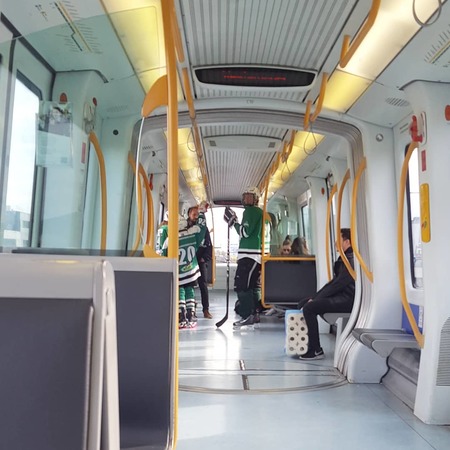
M1 Line:
The green line is the M1 line. It has 15 stations, and it has a route that begins at Vanløse station and ends at Vestamager station. This route has a length of 13.9 kilometers.
The metro is the main transportation option for both the locals and foreigners that want to move throughout the city. It will take you approximately 23 minutes to go from one end of the city to the other within this line.
The M1 line allows you to reach points of interest for tourists and Copenhagen’s citizens, which include universities, music academies and malls.
- Color of the line: Green.
- Number of the line: M1.
- Name of the line: Vanløse – Vestamager.
- Number of stations: 15.
- Length of the line: 13.9 kilometers.
- Time that it takes you to go through the entire line: 23 minutes.
- Schedule: It as a service available at 24/7. In other words, it is available from Monday to Sunday and for 24 hours a day.
Stations. At M1 Line, you will find the following stations in the shown order: Vestamager, Vanløse, Lindevang, Fasanvej,Frederiksberg,Nørreport, Forum, Flintholm, Peblinge Sø,Kongens Nytorv,Islands Brygge,ChristianshavnsKanal, Christianshavn,DR Byen,Sundby, Stadsgraven, Bella Center, ØrestadTrain, E20

M2 line:
The yellow line is the M2 line. It is 14.2 kilometers long, and it has 16 stations. The trains of this line begin their journey at Lufthavnen, and they go through downtown Copenhagen to reach to Vanløse. The estimated time that the trains take to go from one end of the line to the other is of 24 minutes.
Also, the M2 line goes directly to the Copenhagen airport, therefore, you don’t need to make a transfer to another transportation service. The metro goes towards the airport’s terminal 3, where the Lufthavnen station is located.
The passengers that arrive to the airport also have the opportunity to make a transfer to board a train to Stockholm. They could also board other Danish rail services (such as the Danske Statsbaner, also known as DSB.) Finally, the passengers also have the opportunity to board other trains that go beyond Denmark’s border, such as the trains to Sweden.
The Amagerbro station from line M2 is a reference point to travel quickly to restaurants, stores, and leisure facilities. This station is also close to residential areas, industrial parks, beaches, etc.
- Color of the line: Yellow.
- Number of the line: M2
- Name of the line: Lufthavnen con Vanløse.
- Number of stations: 16.
- Length of the line: 14.2 kilometers.
- Time that it takes to travel through the entire line: 24 minutes
- Schedule: It is a service that is available 24 hours a day, 7 days a week.
Stations. The stations for this line are: Lufthavnen, Vanløse, Fasanvej , Frederiksberg, Forum, Peblinge Sø , Lindevang , Nørreport , Kongens Nytorv , Flintholm, Christianshavns , Kanal, Lergravsparken, Christianshavn, E20, Amagerbro, Øresund, Amager Strand, Stadsgraven, Femøren, Kastrup
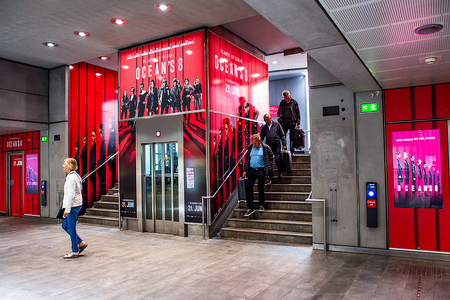
Schedule and frequencies:
The system offers its services 24/7. The train frequency changes whenever the trains start getting crowded.
The peak hours for the Copenhagen metro range between 7:00 and 9:00 in the morning, and range between 2:00 pm and 6:00 pm. The train frequency during these hours are between 2 and 4 minutes.
During off peak hours, the train frequency is between three and six minutes. During night hours, the average frequency is of 20 minutes from Sunday to Thursday, and the train frequency is between 7 and 15 minutes during Fridays and Saturdays.
Connections
Connections between lines can be done on the metropolitan transportation system of Copenhagen. You can also connect to other services, including the S-Train, the regional rails, to the airport, and to international trains.
Connections between lines:
You could make connections between the M1 and M2 lines at the following stations: Vanløse, Flintholm, Nørreport and Christianshavn.
Connections to other systems:
In the following stations, you could make connections to the S-Train, the regional rail services, and the Copenhagen airport:
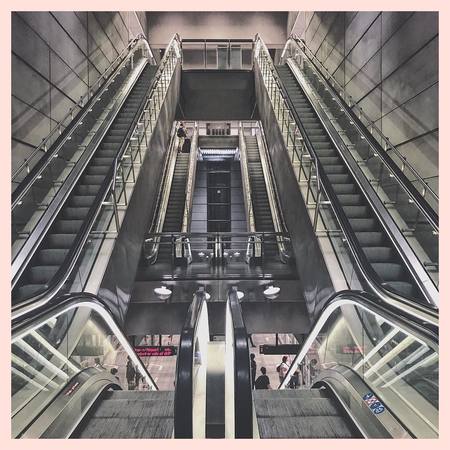 kbenhavn - Kopenhagen -
kbenhavn - Kopenhagen -
Prices, tickets, and passes.
Copenhagen has designed an integrated payment system for the entire public transportation network. There are many types of tickets available, and their price depends on the user’s needs and the zones that they wish to travel to.
A ticket can be used for the metro, the buses, and other trains services available in the city.
You can obtain the travel tickets at the points of sale of the metro, at the stations’ vending machines, and at the airport. These machines accept cash and credit cards.
You could also buy the tickets by the internet through an online app available for smartphones with iOS and Android operating systems.
Single ticket:
The ticket price depends on the number of zones that you wish to travel. Any ticket allows you to travel to a minimum of two zones. The cheapest ticket available costs 24 DKK. A ticket that allows you to travel to thee zones costs 36 DKK. To go to the airport, you need to buy a three-zone ticket.
24 Hour Unlimited Ticket.
Gives unlimited access to all the zones of the system, regardless of if you travel by bus, train, metro. You can also use this ticket to board the buses that go to the ports.
This type of ticket costs 150 DKK for adults, and 75 DKK for people under 16 years of age.
 Field's
Field's
Cards
There are special cards that are recommended for tourists since it brings them a lot of journeys on the metro for an extended amount of time within the city. These cards offer different prices depending on the number of places that you want to visit, the places of interest that you want to go to, among other specifications. This card will allow tourists to save money and enjoy their stay on the city.
- City Pass : It allows you to have unlimited rides, and it’s accepted in the metro, buses, and other train services. This card gives you access to zones 1 to 4. The places within these zones include Downtown Copenhagen and the airport. There are four variations of this card which allow you different lengths of time to use each card, which are: 24 hour card, 48 hour card, 72 hour card, and 120 hour card. You can acquire these cards at the ticket vending machines at any of the stations and at the airport. You could also buy them online through the mobile app.
- Copenhagen Card : Besides offering free journeys to the Copenhagen area, this card gives you access to 75 museums and touristic attractions. Additionally, this card offers you discounts at restaurants, stores, and places offering car rental services.
There are also different cards which last for different periods of time for the Copenhagen Card, which are: the 24 hour card, the 48 hour card, the 72 hour card, and the 120 hour card. You can easily pre-order them online, so you can receive this card at home.
- Flexcard : This card is designed to allow you to travel in any of the integrated means of transportation in the city, offering unlimited rides for a specific number of zones, and it lasts for a week. Its price oscillates between 260 DKK and 620 DKK. There are variations of this card which last for longer than a week.
- Rejsekortet : This is the card designed specifically for frequent travelers that visit Denmark. Tourists and foreigners also have another card designed for them called Rejsekort Anonymous, a card that doesn´t require the user´s private information to get it. It costs 80 DKK. When you buy this card for the first time at a ticket booth or at a vending machine in Rejsekort, you will get an additional 100 DKK for your future journeys.
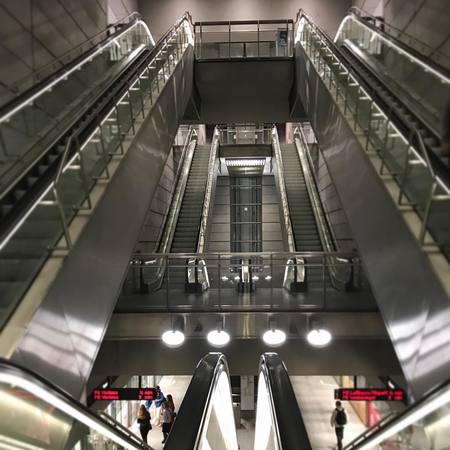 Forum Copenhagen
Forum Copenhagen
Children under 12 years of age travel for free: Up to two children per adult can travel for free. Children between the ages of 12 and 16 can get a discount on their tickets.
Duration of each ticket according to the number of zones travelled:
- The tickets for two and three zones are valid for 60 minutes.
- The tickets for four, five, and six zones are valid for 90 minutes.
- The tickets for over six zones are valid for 120 minutes.
You can board and disembark the trains as many times as you want, as long as you are within the time limit that your ticket allows you.
Pay from your phone through the mobile app:
Paying from your phone is quite simple. First, download the app called "DOT Mobilbilletter" on the App Store or in Google Play. Next, choose your language, and then select the ticket type and fare that you want. Finally, you will have to give your credit card information. You could also buy your tickets for the bus, train, and the metro through this app.
Bicycle tickets:
Copenhagen is unique since there are incentives for the people to use their bicycles on this city, which is a strategy to protect the environment. Bicycles are also allowed on the metro. You need to buy a special ticket so that you can bring your bicycle to the metro.
These tickets are also obtained at ticket booths, at vending machines, and through the mobile app. These tickets are valid for 8 zones, and they last for two hours and 45 minutes.
There are times where bicycles are restricted on the metro, though. During peak hours, which are from Monday to Friday, between 7:00 and 9:00 and between 15:30 and 17:30, bicycles are not allowed on the metro. During June, July, and August, bicycles are allowed all day long, as long as you show a valid bicycle ticket.
To bring you bicycle inside a metro wagon, you need to move it to the center of the wagon. The system also offers a bike parking service in all of the metro stations.
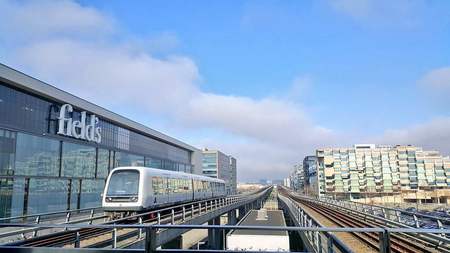
Dog tickets
The Copenhagen metro allows people to bring small dogs in bags. These dogs travel for free.
To travel with dogs breeds of big size, you will need to buy a ticket for children. The only big dogs that travel for free are guide dogs.
Even though big dogs are welcome on the Copenhagen metro, they should be on a leash, and they should stay away from seats reserved for allergic people. These seats are the first and last six seats on the train.
In any case, the security personnel will always be keeping an eye to make sure that the dogs’ presence does not disturb other passengers. If necessary, the security personnel could deny you and your dog entry to the train.
Parking services by the metro
Copenhagen is probably the city in Europe with the least number of car owners. It is estimated that 50% of the people uses bicycles. By summing the length of all the bicycle routes in Copenhagen, we get 320 kilometers of road available for bikes.
For that reason, the only parking service available at the metro system is parking for bicycles. If you want to park your car, you need to use the nearby private parking services.
Rules, tips, and advice
All users should obey the rules of the metro. If you disobey these rules, you may get fined and be asked to leave the metro´s facilities.

- Keep in mind that you always have to buy your ticket. Fines will be given to people that travel without their ticket or to people that use a non-valid ticket. The fine is 750 DKK.
- Always keep your ID while you travel on the metro, since the metro staff could ask you for it at any moment.
- To board the metro, always wait behind the security line at the platform until the train gives you the signal to allow you to enter. This is done for your safety and that of the other passengers.
- All trains from the airport´s station go towards the same direction, so you won´t have to worry about getting lost on the metro. However, you´ll have to
- If you need any help you can always count with the support of the metro´s personnel, which are available at their designated spots. These spots are yellow.
- Remember that bikes are not allowed during peak hours, which are from Monday to Friday, between 7:00 am and 9:00 am, and between 15:30 pm and 17:30 pm. If you bring your bike during these hours, the staff will ask you to leave the facilities, even if you have the special ticket that allows you to bring your bike to the metro. Do not insist on remaining on the area, or you may get fined.
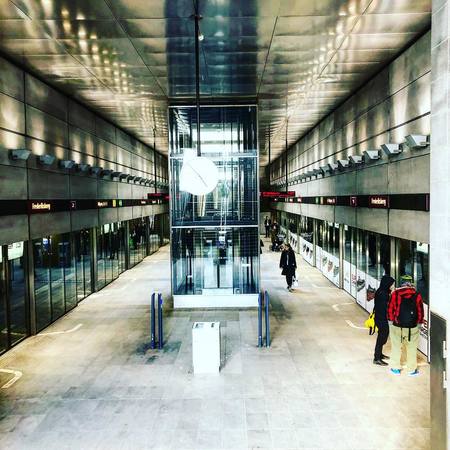 Frederiksberg Station
Frederiksberg Station
Fun Facts
- The stations have a rather modern design. They are unique because they are big and bright, which is a design inspired by the designers KHR Arkitekter. The Forum station is one of the most striking stations in the metro. This station was nominated as a recipient for the Contemporary Architecture European Union Prize on 2005.
- Electric cars have been incorporated on the city of Copenhagen so they can be rented within its public transportation network. Passengers can rent these cars without needing to reserve them beforehand. Another advantage is that there are cards for the metro that can also be used to board the bus, other train services, and the public electric cars. These electric cars belong to the model 400 BMW i3.
- This idea of electric car rental as a public transportation service is called DriveNow. With the DriveNow program, people can rent electric cars and use them within an 85 kilometers radius, and the cars can be recharged at 600 available points. Since people can use these cars at such a big distance, people can drive electric cars within the city without a hassle.
- The DriveNow cars work via an app in which the user only has to send a picture of their face and a picture of their driver’s license. If the photos are accepted, approval is immediate.
- The app indicates the user the parking spot where the car is parked. The electric car should be parked on authorized parking spot, which are free to use.
- The DriveNow program also allows you to rent an electric car directly from the Copenhagen-Kastrup airport.
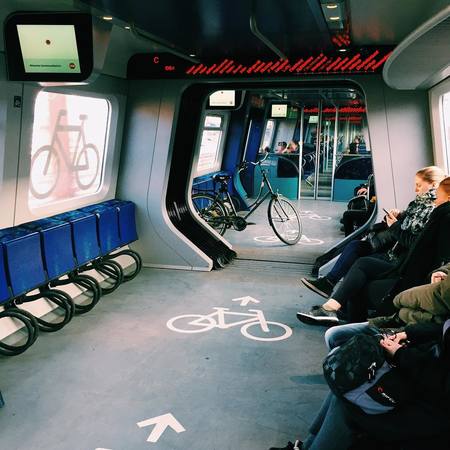 Copenhagen
Copenhagen
Future expansions
There are plans to expand the Copenhagen Metro, which include the construction of the following lines:
- Cityringen: This new line will have a circular shape. It will be built below ground-level, 15.5 km below downtown Copenhagen and Frederiksberg. It will have 17 metro stations, and it is estimated that it will be operational by July, 2019.
- Nordhavn: During early 2020, two stations from the Nordhavn section are expected to be inaugurated. These stations will connect to the Cityringen line.
- Sydhavn: Later, on 2024, five additional stations are planned to be built on the Sydhavn region.
Connection to the airport
The Copenhagen-Kastrup airport is located just 8 kilometers to the southwest of the city. The closest metro station is in a convenient spot. The closest metro station is directly linked to the airport, offering a stop at the airport’s third terminal.
It takes 13 minutes to go from the airport to downtown Copenhagen by using the metro’s M2 line. From the M2 line, you can make a transfer to the M1 line or, in case that you need to go to an area within the city’s outskirts, to the regional rail services.
Keep in mind that the train frequency ranges between four and six minutes during the day, and ranges between 15 and 20 minutes at night.
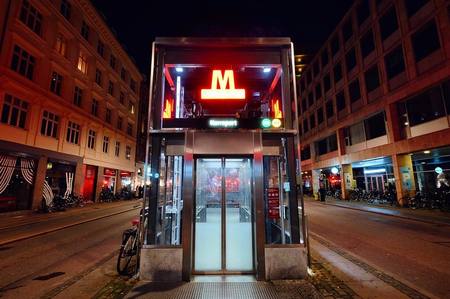 N u00f8rreport
N u00f8rreport
How to reach the Copenhagen-Kastrup Airport:
To go from Copenhagen to the Kastrup Airport you need to take the metro’s M2 line. If you are located near a station from the M1 line, you could make a transfer to a M2 line train without a problem. You could make the connection at any of the transfer stations.
You could also make a transfer to go to Stockholm from the Copenhagen-Kastrup airport. Additionally, you could board a train towards Sweden at the airport.
At the airport’s terminal 3, you can check-in at the self-service ticket vending machines. At these vending machines, you can buy tickets to board a plane and to check-in your luggage.
Media
Tourist attractions to watch by using the Copenhagen Metro
Copenhagen has a lot of touristic attractions. You could visit many of them by using the metro system. Some of them are:
- National Art Gallery
- Amalienborg’s Royal Palace
- Stroget Street
- Tivoli Gardens
- Christiansborg Palace
- Nyhavn (Copenhagen’s Harbor)
- Christiania
- Rosenborg Palace
- National Museum
- Royal Library
- Ny Carlsberg Glyptotek
Copenhagen metro map
- Passengers/Day 126000
- Fares: 2.81
- 24h operation: Every night: Metro
- Air Conditioning: All metro and S-Tog trains
- Walk between platforms: Yes
- Driverless trains: All metro lines (since 2002)
- Screen Doors Platforms: All underground stations
- Average Speed: 40km/h
- Max. Speed: 80km/h
- Operator: Metro Service
- DKK 24
- Copenhagen Metro Official Website
- Tlf: +45 70 151615
Help us
If you consider that the information we provide is wrong, not accurated, outdated, translation contains errors, and you would like to help us to improve the file...you can contact us here.
Feel free to contact us if you dont find the system you're looking for and we'll add it as soon as we can!
Thank you very much!







